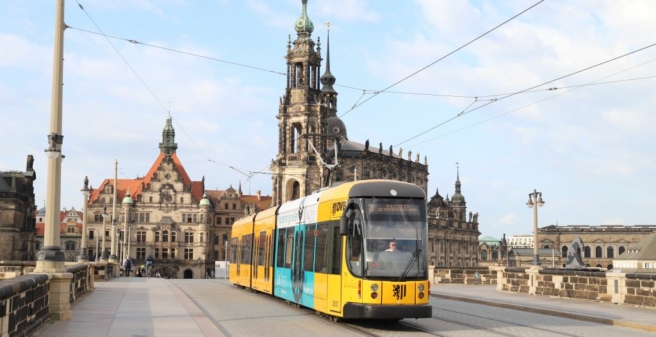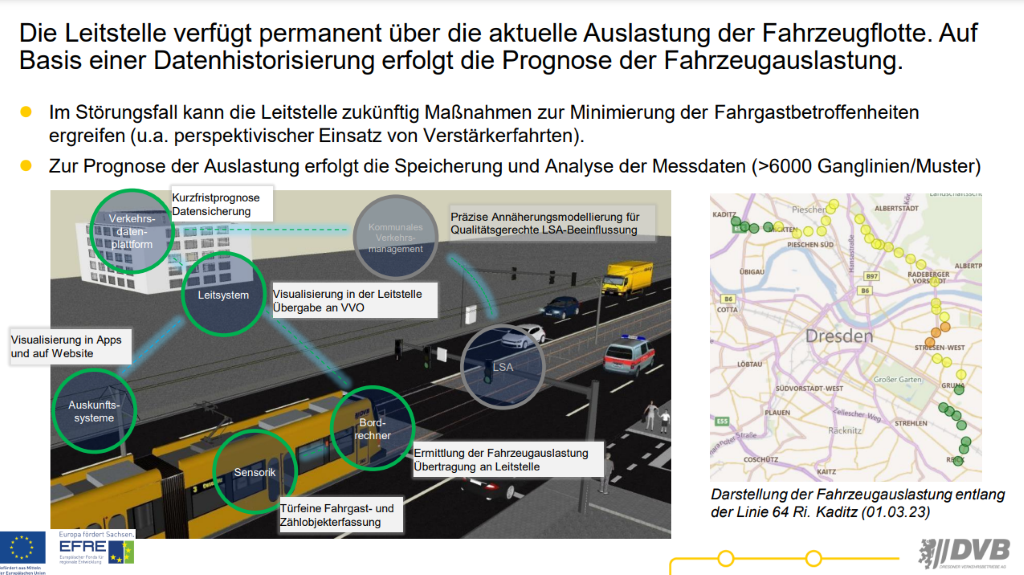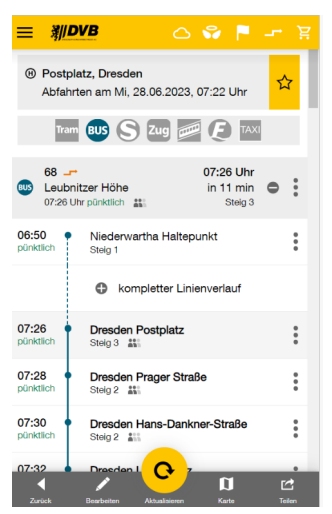
From now on, passengers travelling with the Dresdner Verkehrsbetriebe (DVB) will be able to see how full or empty the tram or bus will be when it leaves the desired stop. This is made possible by an automatic passenger counting system that provides the necessary data and has been installed in the vehicles. The display is part of DVB’s overall project to improve public transport services, which has been running since 2020 and includes, for example, intelligent traffic lights and their control. Of the total project costs of just over ten million euros, the share for the counting systems amounts to almost three million euros and is also 75 per cent subsidised by the European Regional Development Fund.
“My planned journey will have a high capacity utilisation, but the tram only ten minutes later offers a good chance of finding a seat – this information option has been on the wish list of many DVB passengers for some time,” says Martin Gawalek, responsible for traffic management and marketing at DVB, describing the new technology. Recording the number of passengers in the vehicle also provides the basis for specific service adjustments. For example, the control centre can schedule additional journeys when vehicles are full, deploy larger vehicles when occupancy is regularly high or generally increase the frequency. Real-time utilisation is also taken into account when controlling traffic lights. If the carriage is busy, passengers at the stop in front of it will take longer to board or alight. The green phase is then required a little later. Conversely, the driver at the traffic lights should be given the green light more quickly if only a few passengers are boarding or alighting. Analysing vehicle occupancy and demand over a longer period of time is also important for the further development of the route network. “Digitalisation at DVB has long been running at full speed in many areas.
The new counting technology also provides the basis for the introduction of AI-based applications in public transport. These should further stabilise operations in the future, make departures more punctual and reliable and help us to better tailor our services to customer demand in the long term,” summarises Gawalek.


All pictures: © DVB AG Press / Christian Gassel
Unlike the railways, where the expected capacity utilisation of trains is determined primarily on the basis of tickets sold, the DVB system displays capacity utilisation in real time. As soon as the bus or tram has left the terminus, the system registers the passengers boarding and alighting and calculates a reliable forecast based on the current capacity utilisation and stored average values for the respective stops. This means that the expected occupancy of the means of transport can also be displayed for the subsequent stops.
One little man means: plenty of space available
The occupancy of the DVB bus or tram is displayed in the timetable information. This can be found on the Internet at www.dvb.de. It’s quicker on the move on your mobile phone. The DVBmobil app offers the option of purchasing tickets as well as real-time information – either for all departures at a specific stop or for the specific journey between the start and destination stations. In addition to the departure times and the timetable situation, i.e. how punctual the bus or train currently is, a symbol with three little men shows the capacity utilisation of the respective vehicle. One little man means that the vehicle is up to 30 per cent full and there is a good chance of getting a seat. Two little men indicate an occupancy rate of 30 to 70 per cent and three little men mean that the vehicle is very well occupied.
85 per cent of all DVB vehicles already equipped
Passengers are counted by so-called passenger counting systems. For this purpose, 3D stereo cameras have been installed above every door in buses and trams. These record passengers boarding and alighting in anonymised form, so video playback is not possible. The counting data is processed by the respective on-board computer and transmitted to the system.
More than 330 DVB vehicles, around 85 of the entire fleet, are now equipped with this technology. The remaining vehicles will follow by the end of the year. Only buses and trams that are soon to be taken out of service will no longer be fitted with counting devices.
(Info: DVB)
29.11.2023
